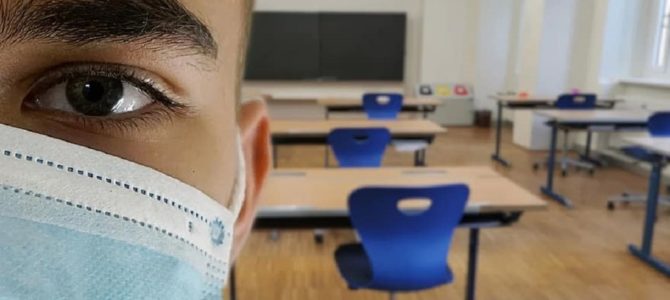
As the coronavirus panic dissipates, alarmists are pushing for public schools to remain closed this fall, or to reopen in completely unworkable configurations that, not accidentally, would require a lot more taxpayer expense during a self-induced employment and tax revenue crisis. But they should think twice about this strategy, because if enacted it would destroy the education monopoly unions and numerous Democrat politicians depend on for money and votes.
I’m fine with that, but most politicians won’t be. Since they care about remaining in power more than just about anything else, they should think about it good and hard.
Establishment voices are claiming schools cannot open this fall, or not without huge extra expenditures on everything from sanitation to hiring additional teachers to slash class sizes. Of course, they ignore that public schools have increased non-teaching employees by seven times as much as student enrollment since 1950. They insist they cannot address this situation by better management of plentiful existing funds.
Senate HELP Committee Chairman Lamar Alexander, for example, just suggested taxpayers should cough up another “$50 to $75 billion to properly equip the 100,000 public schools” and colleges, after Congress already passed multiple trillions in pork-laden deficit spending for coronavirus and every single public program is now in danger. Yet if public schools just matched their staff increases to student enrollment growth, they could find an additional $35 billion every year with existing funds, according to one study.
In addition, many parents are unsure about sending their kids back to schools for a replay of this spring’s chaos. Online learning did not exactly cover itself in glory during school shutdowns. Parents saw how much learning their children had to sacrifice, and how much their children disliked it.
“In Broward County Public Schools in Florida, the district had been building its technology program for several years and many teachers were already managing classwork online, so things have gone more smoothly,” reported the Wall Street Journal, in one example. “Nevertheless, a survey of Broward students in grades 6 through 12 found that 52% don’t feel motivated to complete distance-learning assignments. About 45% said they almost never receive adult help at home to complete assignments.”
Due to the spring school shutdowns, says the superintendent of Miami-Dade public schools in Florida, “The nation should be bracing itself for the biggest ever, precedent-setting, historic academic regression.” What parent or taxpayer is going to maintain support for paying salaries for teachers who are not providing reliable instruction to their kids, or for spending boosts to institutions that are clearly failing to make that happen?
On top of this, for fall some school districts are proposing chaotic schedules like two days on, two days off, and one day of remote learning per week. Others may require children with teachers who are at-risk due to age or pre-existing health conditions to continue substandard online instruction. Some are considering things like isolation rooms for kids who show up with sniffles, and requiring children to spend recess inside hula hoops or chalked boxes on the pavement. Others might cut instruction while expanding daycare.
With ridiculous ideas like these on offer, many parents are likely to reconsider public schooling altogether if it means masking their six-year-olds, no physical interaction ever, indoor recesses every day, and continued craptastic online “learning” that created havoc for working parents and devastated their children’s academic progress. Already, several polls have showed a significant detachment from public schooling due to families’ negative experiences during the coronavirus panic.
“An EdChoice public opinion poll suggests that more than half of parents with school-age kids have a more favorable view of homeschooling after the onset of the COVID-19 pandemic. An unofficial Reason Foundation Facebook poll conducted by Corey DeAngelis suggests that about 15 percent of children could be making the switch to homeschooling in the fall. A May 14, 2020 Real Clear Opinion poll of more than 2,000 registered voters found that as many as 41 percent of parents are more likely to homeschool this fall,” noted Michael Donnelly in The Federalist last month.
Once this exodus starts, it will be hard to stop. Parents have for years told pollsters that private education is their top choice, not public education. They haven’t left yet because it hasn’t gotten bad enough. Long-term coronavirus schooling is easily a tipping point towards “bad enough to finally leave.”It will likely create a cascade effect of long-term parental divestment from public schooling.
Keeping schools closed this fall is thus likely to lead to an exodus from public education, especially among the higher-performing children of married parents who are better able to oversee online instruction or homeschool. This would be another disaster for public schools atop the man-made disaster of poor crisis readiness. The children of married parents make public schools look better than they are because their richer home structure fills in for their own schooling gaps and hides the worse outcomes among children from broken homes.
Married parents, especially mothers, are also known as the most influential group in education politics. Alienating them by shutting down schools again this fall, or making that schooling oppressive to families like it was this spring, would be self-sabotage.
Parents are also very aware that their children are in worse danger from car accidents or the flu than from catching coronavirus. Data from our now-extended experience with the Wuhan flu shows that, for the average person not residing in a nursing home, the risk of death from COVID is lower than the risk of dying in car accidents or contracting the seasonal flu. So if we were using the same risk calculation for shuttering schools due to traffic, they would have never been opened, this fall or any fall.
A lot of resistance among some members of @EdLaborCmte regarding reopening schools. School-aged children are far more likely to die of influenza than of #COVID19. This is CDC data. https://t.co/NByR0VbXos
— Avik Roy (@Avik) June 22, 2020
Government officials are making all this worse by largely failing to provide any consistent, sensible, or clear direction about how they will oversee taxpayers’ $700 billion education spend this school year. “The vast majority of American school districts have yet to announce when they will resume in-person instruction,” the Associated Press reported Tuesday. People hate uncertainty. Leaders who perpetuate it lose the trust of their constituents.
This clear and systemic failure of leadership has already significantly eroded support for public schooling. Extending it will reduce public and parental support for public schools even further. Instead of spending more to offer an even worse education to children this fall, lawmakers really should be giving parents control over their education situations and public financing for it through education savings accounts. That would be a proactive and foresighted response to the inevitable long-term results of this year’s education leadership catastrophe.
At a bare minimum, however, public officials must make sure schools open on time, within budget, and without frustrating CYA rules of dubious health value (masks that kids will finger frequently are probably worse than no masks at all, for example). Alexander did get one thing right: “The surest step back toward normalcy in our country is when 70-75 million college and high school and elementary school students go back to school. They need to go back. Their parents need for them to go back, and the economy needs for them to go back.”









